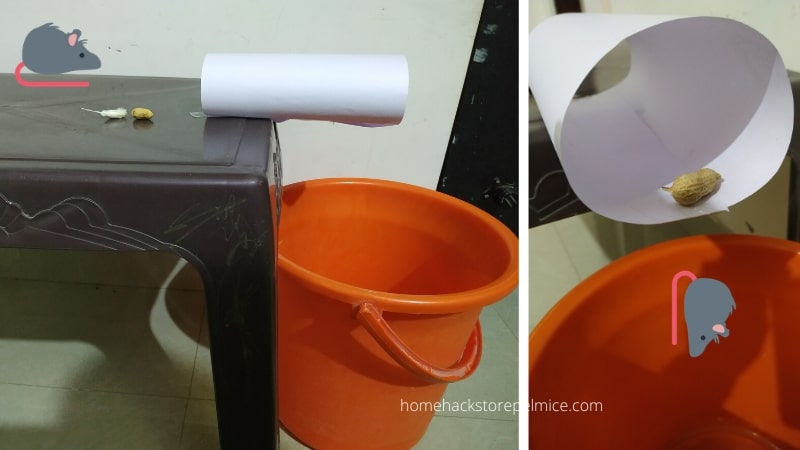Forget all the expensive and complicated rat traps you find on a store shelf. You can easily create a bucket mouse trap, which is one of the easiest and most effective mouse traps.
It’s almost amazing how no manufacturer has created a product out of the superb idea of using a basic bucket trap, which can capture as many mice as you want to remove from your house, without any replacement or resetting!
Without any delay, let’s reveal the bucket mouse trap.
1. Bucket And Spoon Trap
Wondering about how to make a bucket mouse trap? Well, we are here to help you out.
For this trap, you would need a deep-end bucket, a spoon, and some peanut butter or bait of your choice. It is a clever and easier trap to design and execute.
- Firstly, you need a big bucket or tub that can hold 5 gallons of water or more.
- Fill it halfway with water and place it under the table or another elevated platform.
- Place a knife or a spoon with some peanut butter on the side at the edge of the table, directly over the bucket.
- The rat wanting to get to the peanut butter would walk over the spoon towards the edge of the table, allowing you to catch mice in a bucket of water.
There are several variations to this trick that one can play around with. If the idea of rats touching your silverware is disgusting, then you can use toilet paper roll as a substitute.
2. No-Kill Trap
As the name suggests, this trap aims at keeping the rats alive and then transferring them to a place where they can live without harming anybody.
To design this trap, you will need a small tube-like structure, you can use the toilet paper roll. Flatten out the sides so that the tube doesn’t slide off easily. This will be the lure for the rat. Place the tube in the middle of the table, inclined atop any elevated surface.
Then set the trash can or bucket under the tube which is hanging overhead. Set the bait- a tasty treat like peanut butter or a piece of cheese in front of the tube and another treat just above the edge of the tube.
All set with the trap? Now we wait.
The rat lured by the smell of the bait would try to eat it. It will be able to reach the first item on the table beside the tube but upon reaching for the other piece, fall right into the bucket.
A word of caution, the rats will try to jump out, so ensure that the sides of the bucket is high enough to keep it trapped inside. Close the opening and then take the rat to the place where you want to dispose of it.
3. Reusable Traps
Most rat traps, DIY or otherwise can be used only one time. This reduces your chances of getting the rats where you want. One wrong move and the entire plan fails.
Our water pail mouse trap idea is a no kill trap, reusable, and supremely effective.
The entire setup would have to be reset every time it got sprung upon. Also, with these standard rat traps, you will be able to catch only one mouse at a time. The next trap on our list would solve this problem effectively.
This reusable rat trap can be designed using the items in your house. Once you have set it up, you don’t have to bother with it until the trap is full.
To make this trap you will need, a plastic bucket with a capacity of holding five gallons of water, a piece of paper or Styrofoam plate, a steel hook and a few sticks. For this, you can recycle old buckets or paint boxes that you don’t use anymore.
Once you have all the items, the actual designing process starts.
- Drill two holes on each side of the bucket, towards the center.
- Then cut the flat part of the metal hook, ensure that the surface is plain and not twisted in any way.
- Turn the paper or plate upside down and place it on top of the bucket.
- Punch two equidistant holes on the plates, big enough to pass a wire through it.
- Once the plate is perched atop the bucket, use the wires to suspend the entire structure.
- Fill the bucket with halfway water and drop a stick on the side to make it more accessible for the rats.
- Another way to lure the rats would be to pts some peanut butter on the edge of the plate.
The rat, attracted by the tasty bait, would climb into the bucket or get on the plate. The plate would topple, unable to bear the weight of the rat causing it to fall into the water. Using this method, you can trap several rats at once.
4. Wooden Trap
The wooden trap is a bit more complicated but has a higher success rate than other traps. You can easily build a practical and convenient wooden cell mousetrap using items from around the house. To execute the plan you’ll need some wire, a hanger or hook, two rubber bands and a can that has a lid.
The entire structure of the trap resembles a wooden cell. It is designed as a rectangular shape with curved sides that are covered with metallic rods acting as barriers.
- Drill two holes on either side of the can pass the wire through.
- Set the trap in such a way that it is suspended with the help of the steel hanger.
- Position the lid overhead at an inclined angle and attach it to the trap with wires.
- The slightest weight or pressure can topple the lid shutting the can closed.
- Place the bait near the entrance and wait for the rat to come and get trapped in its wooden/metal cell.
You can then dispose of the can far away from the property.
5. Soda Bottle Trap
Soda bottle traps are also very effective in catching mice.
For this, you’ll need an old soda bottle or a plastic bottle, a funnel, some tape, scissors, and some tasty bait.
- Cut the neck of the bottle and make an inch-long incision at the base.
- Extend the cut on the sides till the base, this will be used as the flaps of the trap.
- Then cut out a few diagonal or spiky shapes towards the top of the bottle to prevent the rat from making an escape.
- Insert a funnel inside the bottle and attract it with tape.
- Seal the alternative entrance and set it at an area where rats frequently visit.
- Place the bait over the edge of the trap to attract rats.
- In a day or two, you’ll find rats trapped inside the bottle.
To dispose off the rats you can take the bottle to a remote place and then cut away the tape that is attaching the funnel to the bottle. In case you want to kill the rats, place the bottle in a bucket of water and put a brick over it to keep it submerged. In a day or two, the rats will drown and die.
6. Water Pail Mousetraps
This trap is also morbidly called the “stairway to heaven” trap for it leads the rats straight into the hands of death. To design this trap, you’ll need- a deep-end bucket, a sealed soda can, carpentry tools to drill holes, wire, and a bait.
- Drill two holes on each side of the bucket and fill it with water.
- Take the can and push a metal hanger or ice pick through it.
- Place the can on top of the bucket, balanced on the hanger, like a grill.
- Then skewer the can and pass a wire to extend the can above the bucket at a certain distance. This will keep the can slightly inclined towards the bucket so that it can topple with the slightest pressure.
- To execute the plan, place the trap in a rat-infested area.
- Stick some peanut butter on the top of the can.
- Set up a wooden platform for the rat to climb up and reach the soda can.
Once the rat jumps on top of the can eat the bait, the can would start rolling, causing the rat to lose balance, making it fall in the bucket.
7. Cardboard Box Mouse Trap
Last but not the least, we have the cardboard box trap which is a simple yet ingenious way to trap rats and rehabilitate them. For this, you will need a big cardboard box, some wire, tape, a wooden scale, and a plastic pipe.
Cut out a hole on one side of the box and pass the wire through it.
- Attach the wire or string to the opening flap of the box.
- Use tape to hold the flap upwards and the box open.
- You can place the wooden scale on top of the box to give it some extra balance.
- Tape the scale at an angle that keeps the box tentatively open.
- Place the bait near the entrance or inside the box.
- The rat upon entering the box would cause the wire to snap it shut.
- You can then tape it firmly and take the rats to a different area.
Need for Rat Traps
1. Better than killing them
Trapping and disposing of off the rat to some remote location is the easiest and most humane way to deal with the rat problem. It doesn’t involve bloodshed, there is no cleaning up to do (although we recommend that you disinfect the place), and there’s no murder on your hands. For even though rats are super annoying, that is not a valid reason to kill in cold blood.
2. Better than spending on expensive traps in the market
The rat traps available in the market are often very expensive. Why spend a fortune over the ineffective traps when you can DIY one at home?
3. Easy to create
Rat traps are very easy to design and execute. You can create a really great rat trap using the junk lying around the house. From that old cardboard box in the attic that you don’t use to the tin cans in the garage you’ve forgotten about- everything can be used in a DIY trap. The fact that these traps hardly cost you anything is an added incentive.
Note that the rats can try to escape the box by jumping out or gnawing their way out, so you have to be really quick in transferring them elsewhere.




